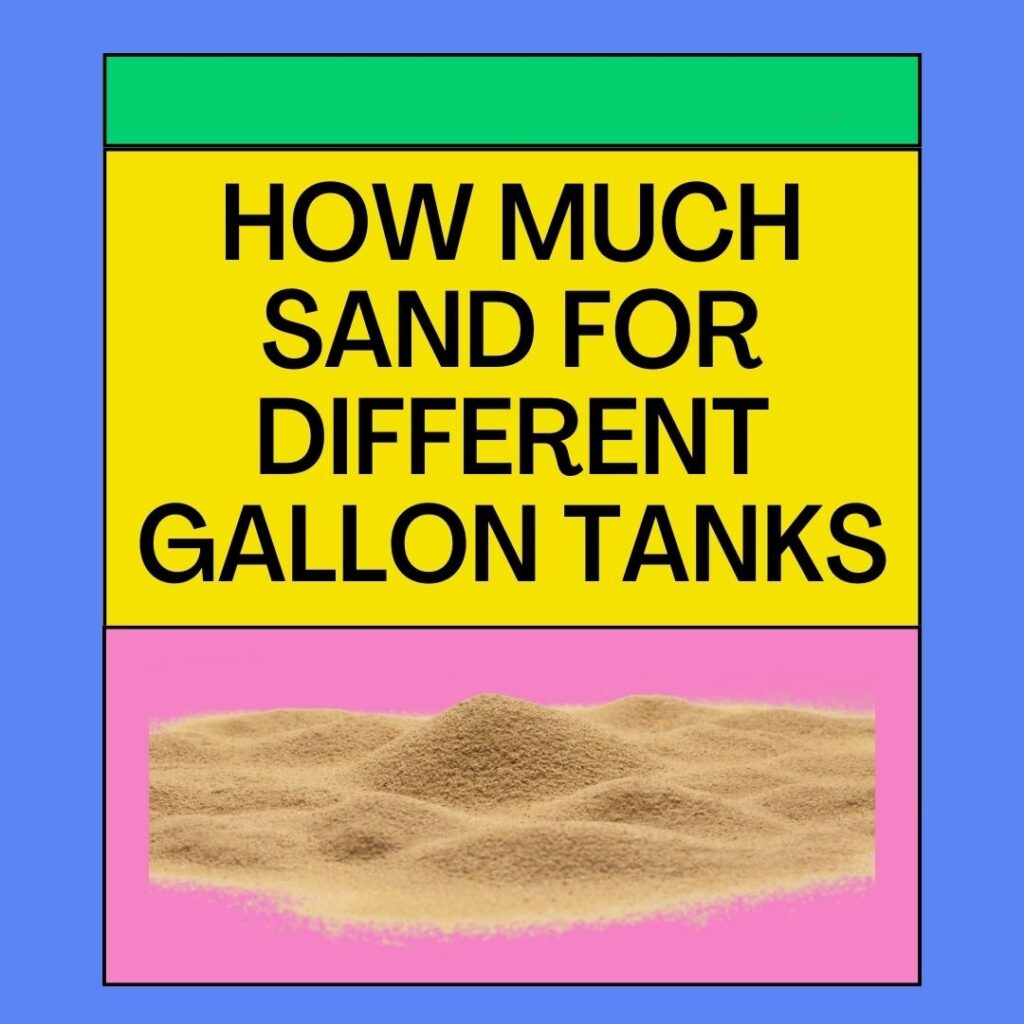Sand helps the beneficial bacteria to grow and also helps in the digestion of the fish. However, it can initially be difficult to determine how much to add.
Hench, which and how much sand for different gallon tanks do you need?
According to studies, a 1″ bed can only be achieved with a 1-pound-per-gallon of sand. In accordance with the size of your gallon, you can compute it. Ones with limited maintenance time should do shallow beds. And the ones who are more plants and decoration should do deep beds.
There are various grains of sand, each of which has advantages that are discussed below. In order to find the right sand for your needs, read about it before placing it.
Read away!

How Much Sand For Different Gallon Tanks?
One could ask what are the advantages of adding sand to the aquarium before placing any. It would also help us understand why and how people use it.
Sand will add brightness to your tank’s appearance. Sand is a good habitat for a lot of species. Many fish species really eat sand, which is a little-known truth. They carry out this action to aid in digestion.
Over-sanding might have some negative effects in addition to positive ones. For this reason, it’s important to be aware of the specific dosages for various gallon sizes. Your tank’s dimensions, shape, and substrate bed depth all play a role in this.
According to research, a 1-pound substrate per gallon plan is required to achieve a 1″ bed. We suggested you use this list as a reference to get the right quantity of sand.
| Aquarium Size (Gallons) | Sand (Pounds) |
| 10 | 10-20 |
| 15/20 | 15-30 |
| 20/29/37 | 29-58 |
| 50/65 | 50-100 |
| 40/55 | 55-110 |
| 75/90 | 75-150 |
| 120 | 12-240 |
| 125/150 | 125-250 |
| 180 | 180-360 |
While we are purchasing the sand, this table will be of assistance. Since the depth was already factored into the computation, changing it would not be a problem.
Depth Of The Sand In The Aquarium
We already know the required amount of sand needed for an aquarium. But the depth can vary from person to person based on their preferred fish. Because different fish prefer different depths of sand for living in.
You may have a shallow or deep sand bed. Between 2.54 to 5.08 centimetres (1 to 2 inches) in depth are shallow beds. Although deep beds can be up to 6 inches deep (15.24 cm).
Shallow Sand Beds
The shallow sand bed gives off a more natural look. It provides more room for vegetation, fish, and water. It looks nicer overall and is simpler to clean.
It’s crucial to keep in mind that you’ll need to clean the sand in the aquarium. Therefore, owners with limited maintenance time may benefit from shallow beds.
Deep Sand Beds
You can fill your tank with additional ornaments and plants if your sand bed is deeper. Since the sand will serve as a sufficient anchor.
However, the accumulation of methane and carbon dioxide can be harmful to deeper substrates. But you may solve this issue by mixing the sand.
Additionally, deeper sand beds provide microorganisms with more area to expand. This growth is vital to the ecology of the tank.
You should therefore select the depth in accordance with your demands.
Types Of Sand For The Aquarium
There are a variety of sand varieties available for your tank. You must consider the size of your fish, your sand grains, along with the color you desire. What you may and cannot put in your tank habitat depends on the sand type you chose.
Aragonite
It is calcium carbonate and has fine grains. This sand helps stabilize calcium and alkalinity levels while maintaining the pH of your tank.
Oolite
It has a diameter of less than 2 mm (0.08 in) and is made up of ooids. This sand aids in keeping your tank’s pH levels constant.
Black Sand
Black sand, often known as Tahitian moon sand, is created by volcanic activity. In this sand, plants develop swiftly. This makes it a perfect choice if you require gravel but prefer sand.
Additionally, black sand encourages the development of good bacteria.
White Sand
This particular sand is susceptible to dirt buildup and bacterial contamination. It probably won’t stay white for really long.
The sand is still excellent for the health of your tank despite losing its vibrant hue. Because it encourages the growth of bacteria.
Pink Sand
Aragonite sand and seashells are combined to create this. It shares aragonite’s advantages. However, it doesn’t need to be refilled and can aid in preventing the growth of algae.
| Product Name | Image | Price |
| Black Sand | $14.77 | |
| AQUANATURAL Oolitic | $14.71 | |
| White Sand | $11.40 | |
| Pink Sand | $9.99 | |
| Coarse Aragonite | $9.65 |
How To Place Sand In The Aquarium?
Sand cannot just be dumped into the aquarium since it will cloud the water. To achieve optimal effectiveness, you must adhere to a few guidelines. It would help you to put the sand in the right manner.
Step 1: Measuring The Sand
Using the aforementioned table as a guide, calculate the amount of sand required for the aquarium.
Step 2: Cleaning The Sand
First, you have to dispose of the aquarium water and let it dry off. Before adding the sand to the tank, you must rinse it. If not, there will be too much dust, which would cause cloudiness that might continue for weeks.
Sand should be added to a bucket together with water to be properly rinsed. Pour unclean water off and agitate the sand. Continue doing this until the water is completely clear.
Step 3: Adding The Rinsed Water
An aquarium should be dry and empty before adding the cleaned sand and water.
After putting a tray on the surface of the sand, pour water over it. It will prevent currents from creating excessive dust agitation.
These processes would make it easier to put the sand without causing excessive clouding.
How To Get Sand To Settle More Quickly
As we already mentioned and would take a little bit of time before settling it. It would make the water cloudy and we’ll be unable to add fish to it. We can help the sand settle faster by following a few things.
- Stop running the filter until the sand is settled.
- Don’t move the aquarium or try to shake it.
- Prevent yourself from adding anything to the aquarium before the sand settles.
Additionally, daily water changes might hasten the settling of the sand in your aquarium. After the sand is settled and the water changes, then you can add fish to it.
FAQs
Do You Cleanse The Sand Before Adding It To The Aquarium?
Before first using it in an aquarium, fresh living sand shouldn’t be rinsed. The good bacteria will be eliminated in this process.
Does Sand Contain Benevolent Bacteria?
The sand bed in the aquarium is a vital place for bacteria to develop. Because it will give aerobic bacteria a fantastic habitat where they can digest nitrite and ammonia.
How Much Time Does Sand Take To Settle In An Aquarium?
Sand will float in the water since it is light. The sand is said to settle in as little as seven days, according to some people.
Conclusion
It was everything related to how much sand for different gallon tanks.
Based on your intended use, you should determine the density and type of sand. Each variant has a specific application, and none is superior to the others.
To help the sand settle more quickly, you can also utilize the suggestions.
Good day!




